Colonial Twilight: The French-Algerian War, 1954-62 is the most recent game in the COIN Series from GMT Games. The game covers the struggle between the insurgent Front de Liberation Nationale (FLN), who are seeking independence from France, and the French Government using locally trained Algerian Troops and Police to keep the peace and try desperately to hold onto one of their colonies. The game is very much asymmetric, with each side having very different approaches to their differing victory conditions as well as different abilities in the form of Operations and Special Activities.
As I have played Colonial Twilight, I couldn’t help but appreciate the effort that the designer Brian Train has put into the game in an attempt to model the approach of each of the protagonists. The Government, with their massive amounts of resources and the power of legal, if not authoritative, control over the local populace is more heavy handed in their methods, utilizing trained Troops to Sweep and Assault insurgent strongholds, moving around the board with great ease utilizing Troop Lift and Deploy. Once they have found and exposed insurgent pieces on the board, they can utilize Neutralize to simply remove them while gaining control of various sectors in order to build Support. In the end, the Government earns victory by keeping the Commitment level of the French people high while increasing support in heavy populated cities and regions.
The FLN is a little more subtle in their methods as they don’t have the power to simply overrun defenses in the country but have to bide their time, building up their presence in key areas by Rallying support for their cause through the establishment of bases from which they can train forces. They then must move unnoticed from region to region Ambushing unsuspecting Algerian Troops, Subverting Algerian Troops and Police over to their cause, and raising the capital needed to fund a protracted war through Extortion. The FLN also utilize darker and more sinister methods, as bombings, assassinations and kidnapping are all on the menu through the use of Terror. They want their freedom from tyranny and are willing to destroy their own country rather than let the French hang on to it for even one more second. In the end, the FLN will win if they can build bases, and protect those bases from the Government, as well as build Opposition in key population centers around the country.
With this introduction, you can see that I feel that Brian Train has done an exemplary job of modeling the chaos and terror that has characterized this conflict between the colonial power and its colony. He has found a way to inject this feeling of dread and despair into the game that involves the movement of very lovely colored cubes and discs around the board representing control, influence and the heavy gloom of terror. In fact, the vehicle by which the game is given the sense of dread, and through which its dark and sinister undertone comes through, is the event cards. In the COIN Series, cards are used to assist the prosecution of the war, as various historical events give rise to a range of abilities, capabilities and benefits that can be used by either of the two antagonists against the other if they can only gain control of the initiative enough to use them.
What is Colonial Twilight About?
Volume VII in the wildly successful COIN Series from GMT Games, as mentioned previously, Colonial Twilight: The French-Algerian War, 1954-62 is an assymetric card assisted war game that is more akin to a Euro game than a traditional hex and counter affair. The game is specially designed for only 2 players, which is a break from the norm for the series, as in the previous 6 volumes there were 4 factions that could be controlled by 1-4 players. This new 2-player only treatment has opened the door to the rest of the world to enter the system with new thoughts and ideas on how to evolve the series. I am referring to a game that I know is in the early stages of development from Vez Arponen as he is attempting to create a 3-player game focused on the Finnish Civil Wars of 1917-1918 called All Bridges Burning. I think that evolution is a good thing and will bring even more fans to follow the series as time moves on. I would like to first take a look at the dynamics of the 2-player system and would like to point out the newest feature to the COIN Series, the redesigned 2-player Initiative Track.
Initiative Track
What is so very unique and great about the Initiative Track used for this special 2-player only version of the COIN Series? Well, I will tell AND show you. Traditionally, in other COIN games, initiative is determined by the order of icons located at the top of the next up Event card in the deck. But in Colonial Twilight, initiative is determined in a very different method. Rather than a random determination from cards, the actions that you decide to take, while you have the initiative will determine your eligibility for the next round. Pretty slick if you ask me!

As you can see from the picture above, the Initiative Track is designed specifically for 2-players and as such has incorporated a very unique method into its function. Each new round, the FLN player will start as the 1st Eligible, meaning that they will get the first choice of the actions they will take, until that it is, they take an action that causes them to lose the Initiative. First off, you will notice that the various spaces are color coded with the 1st and 2nd Eligible boxes. The light tan spaces are similar to the 1st Eligible box, while the darker gray spaces are aligned with the 2nd Eligible box.
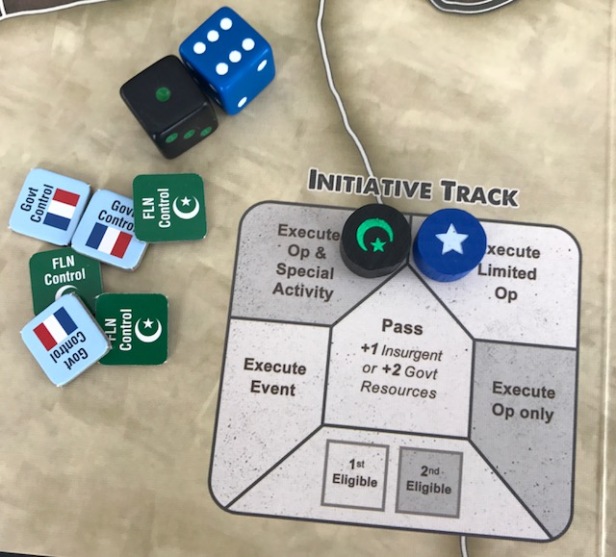
As you can see in this picture, the FLN player has chosen to take the Execute Op & Special Activity space, which will then force him to return to the 2nd Eligible box at the end of the turn. This space is more powerful than say the Execute Limited Op space which only allows for an Op to be taken in one space on the board, as opposed to the full Op which can be taken as many times as you have resources. The neat part of the design of the Initiative Track is that the 2nd Eligible then can only take the actions in a space that is adjacent to the space chosen by the 1st Eligible player. So in this example, the Government player has the choice of three spaces; Execute Event, Pass or Execute Limited Op. After this turn is over, because the FLN player chose the dark tan space with the Execute Op & Special Activity, they will then become the 2nd Eligible player and have effectively lost the initiative. The Government player will now move into the 1st Eligible space and will choose first at the start of the next turn. This mechanic is very well done for a 2-player game and is one of my most favorite parts of the design.

As you can see, the cycle will continue as in the above picture, the Government player now is the 1st Eligible and has the option to choose his actions first. Assuming he chooses the Execute Op & Special Activity space, he will then lose the initiative and become the 2nd Eligible again. This back and forth element of the game is very fun and can become quite strategic. For example, if I am the 1st Eligible, and the Event card that has been drawn from the deck severely damages me or gives the other player a great benefit, I can choose to make that Event impossible for him to take. This is done by simply choosing a space that is not adjacent to the Execute Event space. I can simply take the Execute Limited Op space to effectively block his play of the Event. Sure this action may not be the most efficient for me or give me exactly what I want to do or need to do at that time, but it is a way to strategically keep the initiative and eliminate that negative effect from the Event card. I love this element of the design, I think I have said that already, but it is true!

Operations and Special Activities
I don’t want to go into great detail about all the actions that are available for each player through their Operations and Special Activities, as I am assuming that you have at least a passing familiarity with the COIN Series, but do want to highlight some of the key thematic actions that were designed into the game to model the struggle for the control of Algeria.
For the FLN player, they have access to such mundane actions as Rally, March and Attack but also have some darker options in Terror Operations. This game feels a little like A Distant Plain in the way that the insurgency works. But that is a good thing as o happen to love ADP. First up, lets take a look at one of the most basic, yet versatile, of all actions, the Rally Operation.
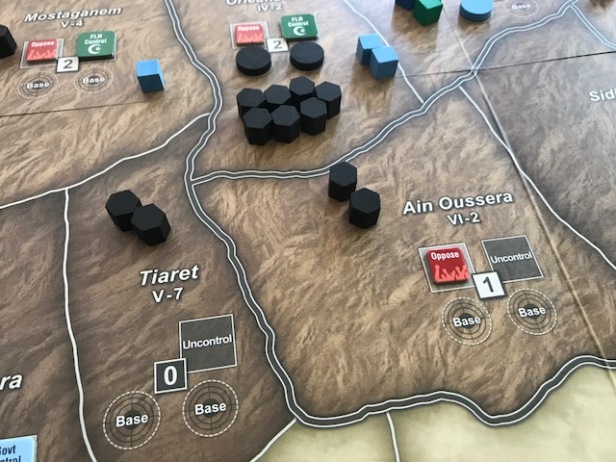
Rally
During our first play, I was the FLN and after battling over the control of Souk Ahras, Tebessa and Philippeville located on or near to the border with Tunisia to the east, I decided to change tactics and switch my focus to the areas around the City of Algiers, specifically in Orleansville. My hope was to establish a large presence there, place a few Bases to help me get nearer to my victory conditions and then begin to spread out into the surrounding areas.
When you take the Rally Op, you have to pay one resource per space that you are trying to Rally in (that space can have Support but you cannot Rally in a City that has Support). The Op allows you to place 1 Guerilla, or replace two existing Guerilla units in that space with a Base. So, in Orleansville, it took me several rounds to be able to get enough units to begin Rally and to eventually place two Bases. Once Bases are placed, Rally becomes more effective as you can place new units up to the total of Population plus Bases in that region. So, in Orleansville, once I had 2 Bases placed, I was able to Rally 4 new Guerillas each round.
I then continued to Rally in that space until I had enough Guerilla units to protect the bases from Government Sweeps and Assaults, as well as to begin moving outward through the use of the March Op. In the picture above, I used the March Op to move 2 Guerilla units south to begin building up in Tiaret and Ain Oussera. Why did I move 2? Well, I wanted to be able to switch the 2 out for a Base as soon as possible to increase my Rally output. This is the type of planning that is key for the FLN player to be effective and feels to me to be very thematic. One unit has difficulty, but a nexus of several units can do more by supporting and aiding each other.
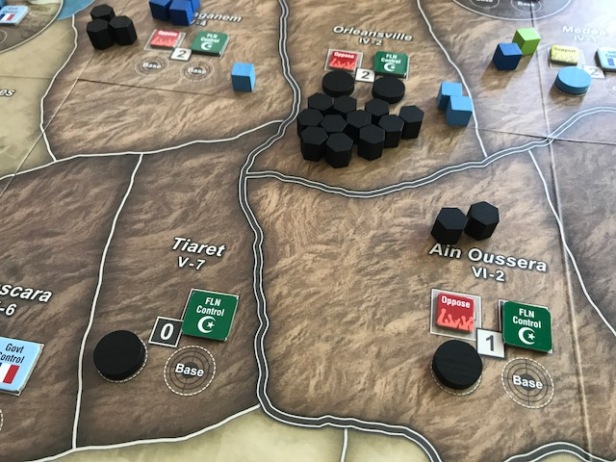
In the above picture, you can see that I switched out my Guerilla units in both of those areas for Bases and then began to continue my Rally efforts in Ain Oussera as I could place up to 2 Guerilla with each Rally Op (remember, Population of 1 + Number of Bases or 1 = 2 Guerilla units). You can also see in the upper left of the picture that I had started to wiggle my way into Mostaganem as well using the same tactics.
Near the end of the game, I was able to establish two strongholds in that area in Orleansville and Mostaganem and more importantly, these 4 bases allowed me to win the game with a final FLN score of -11 to Alexander’s Government score of -12 (as my victory condition is the number of Bases + Total Opposition). I was able to continually withstand his Sweep and Assaults as I would simply do a Rally after he would Sweep to cover back up by Guerilla units and send them underground. Remember, the Rally Op, while very basic, has 3 distinct uses, including adding new Guerilla units, replacing Guerilla units with Bases and covering up your Guerilla units, and you will have to focus on each to be victorious with the undermanned and outclassed FLN.
Terror (So Good, Yet So Bad!)
Terror is also a key Operation for the FLN as they want to affect the Support Level for the Government in key cities. Each time the Government receives Resources during the Propaganda round, they gain resources totaling their Total Support. So, placing Terror Markers is key for the FLN as this removes Support and sets spaces to Neutral. The presence of Terror markers during the Support Phase of the Propaganda Round also hampers the Governments ability to build support. Why? Because the locals feel that the Government can’t protect them and this erodes their support. I love the use of Terror when playing as the FLN as it truly is the only real tool that you have to affect the Government and ultimately win the war. I say that I love using the Terror Ops but I really cringe each time I have to use them as it feels wrong, both morally and ethically, but this is one of the great design elements of the game. Making you think before you act. A lot of times in regular hex and counter wargames, I usually don’t think anything about bombing civilian centers or cities, as there really is no negative effects upon the psyche for doing so. But in Colonial Twilight, the game is so visceral and emotionally evocative, that I actually feel that I have to tread lightly when I am bombing cities as I think about the consequences of my actions through collateral damage.
Extort and Subvert
The FLN Special Activities are also very well done as they have significant thematic connection to the struggle. I am referring specifically to Extort and Subvert. The FLN can raise funds by simply having an underground Guerilla unit in a space with FLN control. The Guerilla simply activates and the FLN gains 1 Resource. I really like Subvert as you can either remove Algerian cubes or change one of those Police cubes into an Underground Guerilla unit. I really liked this as you were stealing their units and creating more of yours. Really cool thematic element.
As for the Government, in my introduction I mentioned that they are more powerful and are really akin to the 800lb gorilla in the room. They have plenty of resources and can move around the board almost at will utilizing their powerful Garrison, which moves masses of Police cubes among spaces and also gives the added benefit of activating one Guerilla unit either in the space they are moving into or in a space they moved from. They can also Sweep into a space, which moves Troop cubes into spaces and also gives the added benefit of uncovering a number of Guerilla units based on the number of Troop cubes and the terrain type (in mountains, they only activate one Guerilla unit per 2 Troops cubes). They also have a really good bag of tricks in their Special Activities. One of the most important though is the Deploy SA.
Deploy
Deploy allows the Government player to literally move population from one sector to another. Why would this be a good thing for the Government you ask? Well, it is kind of like a game of keep-away. If the FLN has Support in an area and has built up a large amount of units threatening a specific sector in an attempt to win the Opposition for that area, the Government can simply relocate those population points to a safer area to thwart the FLN. This way, they may still take over the area and gain Control and even Support, but the Support will be worthless as it is based on population. I loved this aspect and have both done this to my opponent and had it done to me and I can tell you that it really hurts. But, this Government SA really feels heavy handed as they are literally moving people away from their homes in order to maintain control and limit the FLN reach. This is truly a tactic that is included in the Government arsenal that is cold and hate filled, but seems to be right at home in this game filled with terror and chaos.
Neutralize
Neutralize is also very good for the Government, and not so good for the FLN, as it allows their forces to Sweep into a sector uncovering hidden underground Guerilla units and then get rid of them immediately before they can go back into hiding. This is the first time in the COIN Series that I have seen this ability provided and it is very important for the Government player and makes the process of building underground support for the FLN much more difficult.

Pivotal Event Cards
I really enjoyed the Pivotal Event Cards in Colonial Twilight. While not a new idea to the COIN Series, Pivotal Event Cards are very important in Colonial Twilight. Each player begins any of the possible 3 scenarios with up to three Pivotal Event Cards that they can use. The Pivotal Event cards are meant to attempt to include into the historical narrative of the game various important political as well as military events that actually happened and affected the war. I really like these Pivotal Event cards and enjoyed them very much in Fire in the Lake and Liberty or Death also.
What are Pivotal Events? As mentioned above they have a purpose to play in the historical narrative, but mechanically, a player can play their Pivotal Event card in order to replace the currently played Event card from the event deck. The important distinction here though is that each of the Pivotal Events has set pre-conditions that must be met to make the card eligible to be played.
They work like this. If the 1st Eligible player has not yet chosen an option on the Initiative Track, the other player can choose to play their Pivotal Event card, which preempts the normal course of the turn and allows them to carry out the actions listed on the card effectively replacing the shown event card as if it was not there. The player who chose to play their Pivotal Event card places it on the visible Event Card and executes the Pivotal Event actions instead. As a part of the process, the player of the Pivotal Event card will move their cylinder into the Execute Event space and will either become or remain 1st Eligible (see Action Point 1 for a detailed description of the Initiative Track). I loved the Pivotal Events because it is a way to stop a very bad event from taking place that could ruin your plans and to add injury to insult, it allows the player of the card to take back the initiative. The only bad thing is that each side has three of these cards so you will get to do this at least three times to your opponent but will also have it done to you three times as well.
In one of our plays, one of the Pivotal Event cards that I played as the FLN was the OAS card. It is devastating for the Government player as it provides a good, albeit extremely expensive, way for the FLN to combat Support in various regions.
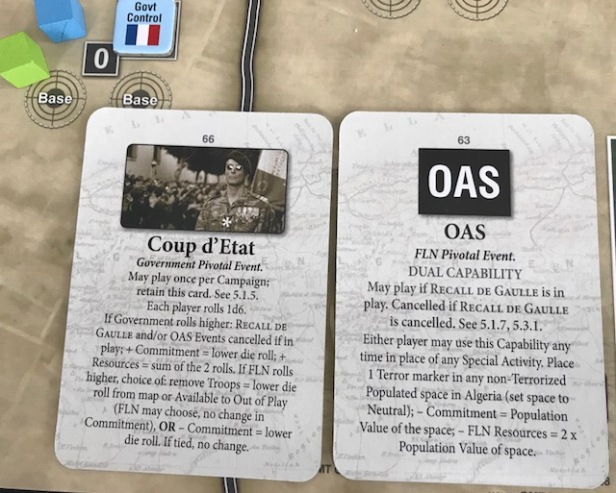
The Organisation Armée Secrète or OAS (meaning Secret Army Organization) was a short-lived right-wing French dissident paramilitary organization during the French-Algerian War. The OAS carried out terrorist attacks, including bombings and assassinations, in an attempt to prevent Algeria’s independence from French colonial rule. Its motto was “L’Algérie est française et le restera” (“Algeria is French and will remain so”).
The OAS was formed out of existing networks, calling themselves “counter-terrorists”, “self-defence groups”, or “resistance”, which had carried out attacks on the FLN and their perceived supporters since early in the war. It was officially formed in Francoist Spain, in Madrid in January 1961, as a response by some French politicians and French military officers to the 8 January 1961 referendum on self-determination concerning Algeria, which had been organised by General de Gaulle.
By acts of bombings and targeted assassinations in both metropolitan France and French Algerian territories, which are estimated to have resulted in 2,000 deaths between April 1961 and April 1962, the OAS attempted to prevent Algerian independence. This campaign culminated in a wave of attacks that followed the March 1962 Evian agreements, which granted independence to Algeria and marked the beginning of the exodus of the pieds-noirs, and in Jean-Marie Bastien-Thiry’s 1962 assassination attempt against president de Gaulle in the Paris suburb of Le Petit-Clamart.
I share that history with you as I wanted to show that this element as well is firmly grounded in realism and shows the depth of the game and its design. So, there is a restriction on the use of the OAS card and when it can be played, which in some ways limits its effect, and attempts to balance its terrible power. The card may be played only if de Gaulle is in power, which requires and is cancelled if the de Gaulle card is cancelled with the play of a Coup d’etat. This card also is one of two dual Capability cards contained in the game, and playing it gives either of the players its ability. Why is the card so good for the FLN and so terrible for the Government? Well, it allows the FLN to spread havoc in a space by placing a Terror marker and then sets that space to Neutral, AND has the added benefit of reducing the Commitment for the Government player by the amount of the Population of the space. It also though has a steep price for the FLN though as it will cost resources in the amount of the Population so it must be used judiciously as I am sure its dark tactics were used sparingly as well.
As a dual capability card, the Government player can use this as well so it really can be a poison pill. If you live by terror, you will also die by terror! I have used this card to terrible effect near the end of games to continue to reduce the Support level of key cities, such as Algiers, which not only reduced the Support level for the Government player’s victory conditions, but had the added benefit of reducing his Commitment level. Your opponent will be able to get the Support back fairly easily, at a cost of resources and time of course, but he will not be able to get back the Commitment that has been lost. This card can be really brutal if used at the appropriate time and highlights the game’s darker side.
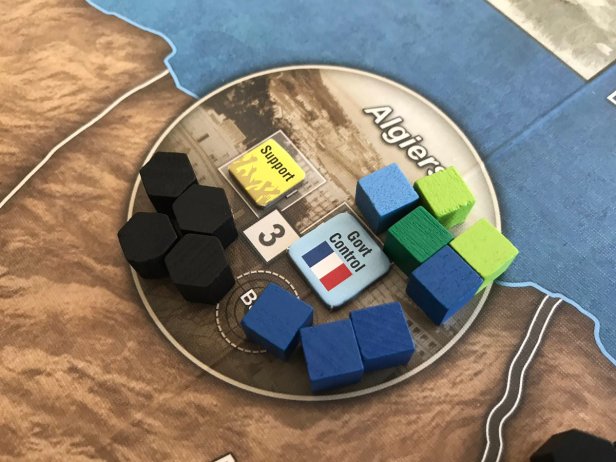

Too Much Attention Focused on the Various Abstracted Tracks (both France and Border Zone Status) – As you read above, you can see that I really liked the inclusion of these tracks in the game as they filled an historical element with a very fitting and well done abstraction. What I don’t like is that this is simply one more thing to have to worry about and focus on. I will say that if either player ignores either of these tracks, it will be game over for them. They have that much of an impact on the game that you cannot forget about them. I remember during our very first play, I gave up on the Border Zone Status track as the FLN, and low and behold, that came back to bite me in the end when my interior bases were eliminated. I had a lot of trouble getting back into the game. I guess what I don’t like is that as experienced players, we both will typically counteract or undo whatever change in either of the tracks that happened the round before immediately upon our next opportunity. This just tended to lead to a bog down and a focus on the tracks that took away from the other elements of the game. I know that the tracks complement each side, but it just seemed to add a little more complexity than was necessary to the game.
Summary/Conclusion
I really enjoyed Colonial Twilight and feel that it is now firmly entrenched in my top 3 favorite COIN Series games. I was pleasantly surprised by the game, as at first, I didn’t necessarily feel drawn into the theme or time period as I have with other entries in the series such as Fire in the Lake or Pendragon (this feeling is more of anticipation as it doesn’t release until next month). But after playing for the first time, I definitely could feel the allure of the design and became interested in the time period which lead me to doing some internet reading on the war itself and the many issues and problems inherent with it. (That is one of the reasons that I love historic themed games!) I was really impressed with the integration of the theme into the gameplay and the care given to make sure players actually feel the consequences of their actions. As I have played the game, I have paused many times to simply think about things, either my actions during the game, the moral turpitude of the two combatants (who is the good guy? Is there even a good guy?), the purpose and meaning of it all, etc. I truly believe that this is Brian’s masterpiece, his Mona Lisa, David or Sistine Chapel as it were. The skill with which he has weaved the bitter elements of the struggle together in a playable and enjoyable way is nothing short of triumphant. And any game that can make you think about things is a good thing. Bravo, I say! Bravo.
For the masterpiece that this game is, it is not for the feint of heart, the novice or even for everybody, as the game is deceivingly complex and not for those who are new to the COIN Series. After we posted our Video Review, I was asked by a subscriber if we thought it was a good game to introduce new players to the genre and I responsesd as follows:
“I don’t know that I agree that this is a Gateway game to the COIN System. There is some real hidden complexity in this game that requires a solid and experienced knowledge of the system. If I had to say which of the COIN Games could be considered a Gateway game, I would say Cuba Libre. CT is pretty complex really and needs players that have a basis in the system. In my experience, the FLN is very hard to play and to play well and even create a challenge for the Government player. If the FLN is played by a novice, the Govt will have their way with them, and it won’t even be close. This reminds me of games like Labyrinth.”
We always say that COIN Games are extremely fun and playable but mind melting at the same time. You cannot understand what it is that I am trying to say until you stare at the Player Aid for the 1st time and have to try and ask yourself, “What am I trying to do?” and then the inevitable follow-up question, “How am I going to do that?”. I felt that with this design my friends. I felt that in my very soul and it was glorious.
For more information on the components (as I didn’t really cover that aspect in my review at all), please check out our unboxing video.
-Grant

 Grittiness of the Cards (No Fear on their Use)
Grittiness of the Cards (No Fear on their Use)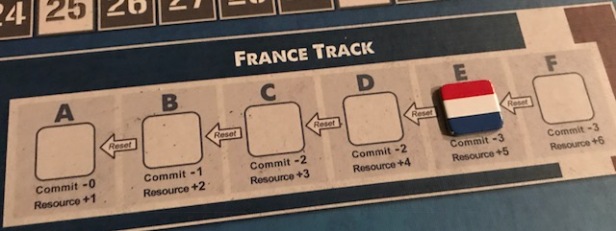
Thank you so much for the wonderful review Grant!
I am so pleased that you liked this one.
And it’s my birthday today too!
LikeLiked by 2 people
This is a materpiece of a review/overview of this superb game. Thanks
LikeLiked by 1 person
Thanks. The game is a masterpiece in and of itself and it made it really easy to write about.
LikeLike